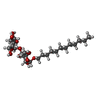+Search query
-Structure paper
| Title | Structural basis and evolution of the photosystem I-light-harvesting supercomplex of cryptophyte algae. |
|---|---|
| Journal, issue, pages | Plant Cell, Vol. 35, Issue 7, Page 2449-2463, Year 2023 |
| Publish date | Jun 26, 2023 |
 Authors Authors | Long-Sheng Zhao / Peng Wang / Kang Li / Quan-Bao Zhang / Fei-Yu He / Chun-Yang Li / Hai-Nan Su / Xiu-Lan Chen / Lu-Ning Liu / Yu-Zhong Zhang /   |
| PubMed Abstract | Cryptophyte plastids originated from a red algal ancestor through secondary endosymbiosis. Cryptophyte photosystem I (PSI) associates with transmembrane alloxanthin-chlorophyll a/c proteins (ACPIs) ...Cryptophyte plastids originated from a red algal ancestor through secondary endosymbiosis. Cryptophyte photosystem I (PSI) associates with transmembrane alloxanthin-chlorophyll a/c proteins (ACPIs) as light-harvesting complexes (LHCs). Here, we report the structure of the photosynthetic PSI-ACPI supercomplex from the cryptophyte Chroomonas placoidea at 2.7-Å resolution obtained by crygenic electron microscopy. Cryptophyte PSI-ACPI represents a unique PSI-LHCI intermediate in the evolution from red algal to diatom PSI-LHCI. The PSI-ACPI supercomplex is composed of a monomeric PSI core containing 14 subunits, 12 of which originated in red algae, 1 diatom PsaR homolog, and an additional peptide. The PSI core is surrounded by 14 ACPI subunits that form 2 antenna layers: an inner layer with 11 ACPIs surrounding the PSI core and an outer layer containing 3 ACPIs. A pigment-binding subunit that is not present in any other previously characterized PSI-LHCI complexes, ACPI-S, mediates the association and energy transfer between the outer and inner ACPIs. The extensive pigment network of PSI-ACPI ensures efficient light harvesting, energy transfer, and dissipation. Overall, the PSI-LHCI structure identified in this study provides a framework for delineating the mechanisms of energy transfer in cryptophyte PSI-LHCI and for understanding the evolution of photosynthesis in the red lineage, which occurred via secondary endosymbiosis. |
 External links External links |  Plant Cell / Plant Cell /  PubMed:36943796 / PubMed:36943796 /  PubMed Central PubMed Central |
| Methods | EM (single particle) |
| Resolution | 2.66 - 2.71 Å |
| Structure data | EMDB-33659, PDB-7y7b: EMDB-33683, PDB-7y8a: |
| Chemicals |  ChemComp-CLA:  ChemComp-KC2:  ChemComp-II0:  ChemComp-II3:  ChemComp-IHT:  ChemComp-LMG:  ChemComp-LHG:  ChemComp-SQD:  ChemComp-8CT:  ChemComp-LMU:  ChemComp-PQN:  ChemComp-SF4:  ChemComp-DGD: |
| Source |
|
 Keywords Keywords |  PHOTOSYNTHESIS / PHOTOSYNTHESIS /  Cryptophyte / Cryptophyte /  Photosystem I / Photosystem I /  evolution evolution |
 Movie
Movie Controller
Controller Structure viewers
Structure viewers About Yorodumi Papers
About Yorodumi Papers







 chroomonas placoidea (eukaryote)
chroomonas placoidea (eukaryote)